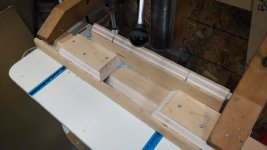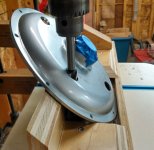evolutiongts
10 kW
40mph with the stock rim and spokes but after 4 months of riding the spokes are getting loose and the wheel untrue. Still runs smoothly at high speed but I will be switching to a crystalyte motor shortly.
evolutiongts said:40mph with the stock rim and spokes but after 4 months of riding the spokes are getting loose .....
teslanv said:Yeah, I know the crowns and Cromotors are the kings right now hub wise. But being my first mod like this I thought it would be wise to "Practice" my craft work on something less valuable, and also a motor that won't be overkill on my current bike.
That's a convincing argument, wesnewell. Maybe, just upgrading the phase wires right out of the shaft would suffice?wesnewell said:Here's my thoughts on phase wires. A chain will fail at its weakest link. The same goes for electrical wiring. So what good does it do to use 12awg phase wires if the motor coils are 14awg? All you really gain is less voltage loss between the controller and motor coils. There's a 2.1V drop in a 4' circuit (about the length of the stock phase wires from motor to controller at 40A) using 18awg wire. 16awg is 1.33V. 14awg is .83V. 12awg is .52V. Now just shorten the phase wires to a 2' circuit and the losses will be cut in half, so you can eliminate a lot more by just making the connection from the controller to motor shorter. Doubling the amperage will double the loss. Personally I'd rather burn up the phase wires than the motors coil wires. That's why I'm just going to shorten the stock phase wires just outside the motor and replace the rest to the controller with 10awg and shorten it to needed length, which is only about a foot in my case since my controller wires come out right at the BB. You can figure voltage losses with the calculator at the bottom of this link.
http://www.powerstream.com/Wire_Size.htm
wesnewell said:........The same goes for electrical wiring. So what good does it do to use 12awg phase wires if the motor coils are 14awg? ......
Here's my thoughts on phase wires...what good does it do to use 12awg phase wires if the motor coils are [the smaller] 14awg?
Punx0r said:I've currently got a thermocouple wired in mine. Would a 10K NTC thermistor be better? I'm thinking compatibility with various off-the-shelf temperature displays.
What controller/Current are you running on that Video, zombiess?zombiess said:I pushed my 9C 2806 harder than most people have a 28mm stator, 58mph top speed on 125V. Trick is minimizing the load, small diameter tire, lower turn count (higher KV) so the saturation point is higher, and ventilating the motor. This motor still works great, windings look brand new and is now on my Wife's bike living a much calmer life.



